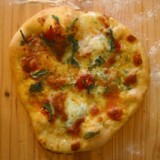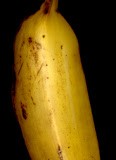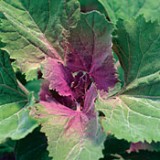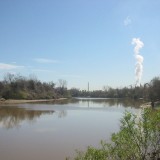
The foraging and culinary partnership of Pascal Baudar and Mia Wasilevich continue to make amazing discoveries. I’d describe their work as elemental–start with wild, local ingredients, use direct but often novel techniques to create a cuisine at once sophisticated and neo-primitive. We blogged about their acorn processing workshop back in October. This month we were fortunate to have taken their class on cooking with clay.
This is an ancient cooking technique. Clay provides the insulation necessary to keep the fish from scorching on the fire. You can also try cooking veggies and firm fruit in clay, though Pascal also showed us that for veggies, a layer of grass can also work quite nicely. The principle is the same: insulation. We’ll talk the grass/veggie technique at the end of this post.
For cooking a fish in clay, the first step is to find clay either in the wild or, in the case of this workshop, from the local art supply store. If you’re buying the clay, it doesn’t matter what kind–so go for the least expensive type. If you are harvesting your own clay, just make sure the ground in that spot you’re digging in isn’t polluted, e.g. the site of an old gas station. If you do dig your own clay, and find that it is not pure enough to hold together well, try adding an egg white to the mix.
Once you have your clay and are ready to start cooking, soften up the clay by adding a little water to it and kneading it until it’s soft and pliable:

The next step is to find yourself some big leaves for wrapping your food. We were using big sycamore and curly dock leaves. If you can’t find any big leaves in the wild, I’m sure chard or cabbage leaves would work beautifully. I’ve also seen banana leaves in Asian markets, which would be good for ambitious projects.
You will also need some natural fiber string for tying things up–we were using strands of yucca fiber. All cotton kitchen twine would also work.
Sycamore leaves are so big that two overlapping leaves pretty much took care of one trout, as below:

With smaller leaves, like the dock leaves, it takes more leaves, more patience, and more artful arrangement:

But we’re getting ahead of ourselves. Before the fish is wrapped, it needs to be seasoned, and dressed with a little fat. We were using butter infused with wild herbs, but olive oil is great too. The herbs we were using in the field included a type of wild clover, sagebrush, wild mint, native sage, white pine and watercress–but not all on one fish! I think a little lemon and garlic slipped into our cooking, too, here and there, and of course, salt and pepper — um…all wild foraged, of course.

Once the fish is dressed for dinner, it gets tied up in leafy bondage. This is where the yucca fiber or some other type of string or natural cordage comes in handy. It’s imperative that the fish doesn’t touch the clay–it will stick. So every inch of the fish must be well wrapped:

After the fish is wrapped, the entire leafy package needs to be covered with about 1/2 inch of clay. The coating should be even, for consistent results. You can opt to pat the clay on bit by bit, building up the coating — like this:

Or, as Sergio, a chef in attendance pointed out, you can roll out the clay first so it’s all tidy and assured to be of equal width all across. Sergio made a lower piece, placed his fish on it, and then capped it with another matching piece and pinched the edges closed–sorta like a pie, or a calzone, or an empanada, or any manner of delicious things. This sort of forethought is what separates chefs from the rest of us. Behold Sergio’s beautiful fish:

Once the clay is applied, the fish goes on the hot coals for 10 minutes on each side. This timing applies to a trout in 1/2 inch of clay. Differently sized fish and different thicknesses of clay will effect the timing.

When the package comes off the fire, crack open the clay and peel the pieces off of the leaf coating. This is the exciting part, and would be really dramatic at the dinner table. When served while hunkered around the fire, it appeals to our inner cavemen.



Inside, the fish was fragrant and perfectly moist. The clay protects it from drying out, and bathes the flesh in herbal steam. It was, no lie, the best trout we’ve ever eaten. Erik and I are going to try this out at home in our bread oven, perhaps after a pizza course!
Veggie Options:

I have to admit, I was so obsessed with trout process, I missed some of what was going on at the vegetarian table. But in essence the process is the same. You can dress sturdy veggies like carrots and baby potatoes with fat and herbs, wrap them with leaves, cover that with clay and throw it on the coals. Pascal also recommended trying fruit, like pears. He likes pears with native California black sage.
Better still, you can skip the clay and use grass instead, which is much easier for impromptu cooking. Grass is good insulator, maybe not good enough for a delicate trout, but plenty good for carrots. Just gather yourself a bundle of green grass. Pascal likes some fallen leaves mixed in with the grass, for the earthy aroma that adds. Do be careful that you don’t accidentally pick up some poison hemlock leaves or other poison or irritating plants when you grab your grass.
Lay your big leaves out, as for the fish, then put down a fat layer of tangled grass, then top that with your veggies. (It reminds me of an Easter basket, but an Easter basket that would make most kids weep: “Potatoes for Easter??”) Then season away with herbs, fat, garlic, salt and pepper–whatever takes your fancy–and wrap the leaves up around the grass insulation, to make sort of a green burrito. As with the fish, you’ll want to tie the packets/burritos closed with some sort of natural fiber or string.


The leaf bundles can go on a grill above the fire. If you want to cook these packs straight on the coals, you should use clay packs instead.

Pascal said that cooked this way, carrots should be done in about 15 minutes, small potatoes in about 25 minutes, full sized potatoes in an hour.
To find out more about Pascal and Mia’s classes, check out Urban Outdoor Skills and Transitional Gastronomy. It’s worth a trip to Los Angeles to take a class. Their Meetup groups are The Los Angeles Wild Food and Self-Reliance Group and Foraging Foodies LA. Friend them on Facebook for a daily dose of astonishing photos.





Hopefully you took the used baked clay and threw it in a bucket with some water to reuse it again another time.